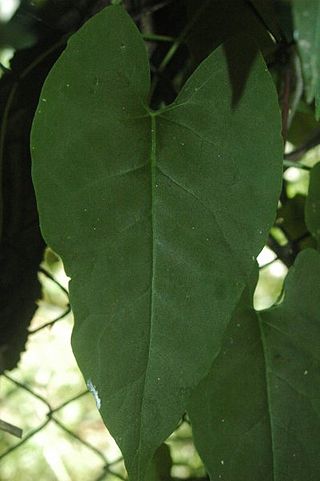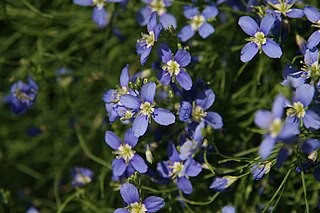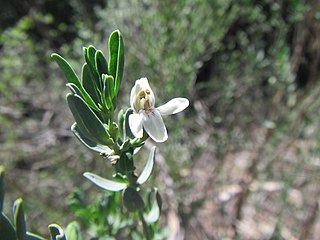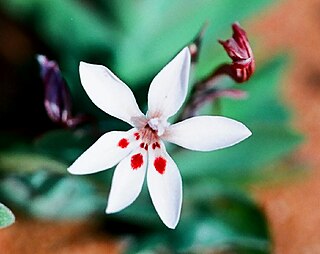
Erica is a genus of roughly 857 species of flowering plants in the family Ericaceae. The English common names heath and heather are shared by some closely related genera of similar appearance. The genus Calluna was formerly included in Erica – it differs in having even smaller scale-leaves, and the flower corolla consisting of separate petals. Erica is sometimes referred to as "winter heather" to distinguish it from Calluna "summer heather".

Rosa multiflora — is a species of rose known commonly as multiflora rose, baby rose, Japanese rose, many-flowered rose, seven-sisters rose, Eijitsu rose and rambler rose. It is native to eastern Asia, in China, Japan, and Korea. It should not be confused with Rosa rugosa, which is also known as "Japanese rose", or with polyantha roses which are garden cultivars derived from hybrids of R. multiflora. It was introduced to North America, where it is regarded as an invasive species.

Elaeagnus, silverberry or oleaster, is a genus of about 50–70 species of flowering plants in the family Elaeagnaceae.

Luzula campestris, commonly known as field wood-rush, Good Friday grass or sweep's brush is a flowering plant in the rush family Juncaceae. It is a very common plant throughout temperate Europe extending to the Caucasus. This species of Luzula is found on all types of native grasslands, and cultivated areas such as lawns, golf-course greens and fields.

Eucalyptus deglupta is a species of tall tree, commonly known as the rainbow eucalyptus, Mindanao gum, or rainbow gum that is native to the Philippines, Indonesia, and Papua New Guinea. It is the only Eucalyptus species that usually lives in rainforest, with a natural range that extends into the Northern Hemisphere. It is characterized by multi-colored bark.

Reynoutria multiflora is a species of flowering plant in the buckwheat family Polygonaceae native to central and southern China. It is known by the English common names tuber fleeceflower and Chinese (climbing) knotweed. It is known as he shou wu in China and East Asia. Another name for the species is fo-ti, which is a misnomer.

Burchardia is a genus of herbs that are endemic to Australia. The genus is named for Johann Heinrich Burkhardt, a German botanist.

Malva multiflora is a species of flowering plant in the mallow family known by the common names Cornish mallow and Cretan hollyhock. It is native to western Europe, North Africa, and the Mediterranean Basin, and it is naturalized in areas with a Mediterranean climate, such as parts of Australia, South Africa, and California. This is an annual or biennial herb growing a tough, somewhat hairy stem to a maximum height between 1 and 3 meters. The leaves are multilobed with flat or wavy edges, slightly hairy, and up to 10 centimeters long. The plant bears small pink or light purple flowers with petals just over a centimeter long. The fruit is disc-shaped with 7 to 10 segments.

Luzula multiflora, the common woodrush or heath wood-rush, is a species of flowering plant in the rush family.

Fockea is a genus of succulent scrubs native to Africa south of the equator. They are members of the Asclepiadoideae (milkweeds), a subfamily of the dogbane family Apocynaceae. Of the six recognized species, only the two most widely distributed extend north of southern Africa, with F. multiflora reaching as far north as Tanzania and F. angustifolia reaching to southern Kenya. Fockea are known as water roots, a reference to the bulbous caudex characteristic of most species, which is also edible in at least some species.

Fockea multiflora, or python vine, is a plant of the dogbane family, Apocynaceae, native to Tanzania, Mozambique, Zimbabwe, Zambia, Angola, Botswana, Namibia, including the Caprivi Strip, and Malawi. It is a large semisucculent liana, growing to some 15m in length and up to 60 cm in diameter, found primarily in the seasonally dry tropical biome.

Wachendorfia thyrsiflora, the marsh butterfly lily, is a plant species of 0.6–2.5 m (2.0–8.2 ft) high when flowering, that has been assigned to the bloodroot family. It is a large to very large evergreen perennial plant with an underground rootstock with clusters of roots produced at the nodes. The rootstock has a distinctive red colour that results from so-called arylphenalenone pigments. The sturdy, entire and broadly sword-shaped leaves have laterally flattened and pleated leaf blades. The golden yellow flowers are set a dense cylindrical panicle on a tall firm stalk. Flowering occurs from spring until mid-summer.

Wachendorfia brachyandra is a small to large, 10–65 cm (3.9–25.6 in) high, winter-growing, perennial herbaceous plant that grows from a rootstock, and has been assigned to the bloodroot family. Its simple, entire, line- to lance-shaped leaves that are usually shorter than the stem, and have pleated, laterally flattened leaf blades af about 35 mm (1.4 in) wide, meaning that there are left and right surfaces rather than upper and lower. The inflorescence is a lax panicle and at the base of each flowerstalk is a dry, brown and papery bract, and those higher in the panicle have a recurved tip. The mirror-symmetrical pale apricot-yellow flowers consist of six tepals and are adorned with brown markings on the upper three tepals. There are three anthers that are clustered and about half as long as the tepals. Each individual flower only lasts one day. Flowering occurs from August to December. This species grows in the wild in the Western Cape province of South Africa only, and is much less common than its relatives W. paniculata and W. thyrsiflora. It is sometimes called short-stamen butterfly-lily in English.

Crassula umbella is a succulent plant species in the genus Crassula. It is endemic to the Cape Provinces of South Africa.

Stachys rugosa is a species of perennial herb in the genus Stachys.

Lebeckia plukenetiana is a species of flowering plant in the genus Lebeckia. It is endemic to the Western Cape of South Africa.

Heliophila coronopifolia is a species of flowering plant in the genus Heliophila. It is native to the Northern Cape and Western Cape provinces of South Africa.

Justicia cuneata is a species of shrub in the genus Justicia. It is endemic to the Cape Provinces of South Africa.

Lapeirousia arenicola is a species of flowering plant in the genus Lapeirousia. It is endemic to the Northern Cape and Western Cape of South Africa.

Drosanthemum schoenlandianum is a species of succulent plant in the genus Drosanthemum. It is endemic to the Cape Provinces of South Africa.





















